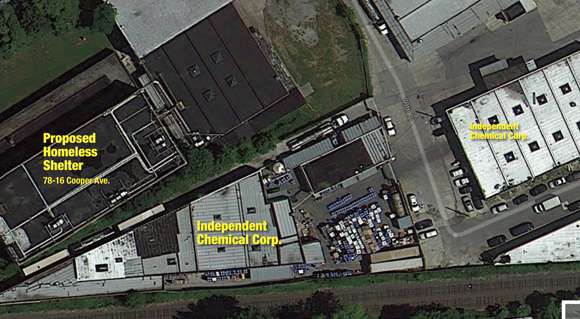The New York City Department of Homeless Services has proposed a 125-unit transitional housing facility at 78-16 Cooper Avenue, Glendale, Queens.
The building, constructed in 1927 and formerly an airplane factory (among other uses), has been vacant for several years.
It has been widely reported that the proposed facility will shelter homeless families with children. Samaritan Village, a not-for-profit organization that runs about 20 similar homeless facilities throughout the city, plans to operate the shelter.
However the placement of the shelter in the middle of a hazardous industrial complex is alarming on several levels. The site is located in a manufacturing zone that includes the Independent Chemical Corporation on 79th Place and the former Kliegman Brothers dry cleaning warehouse. A cleanup of an underground plume of chemicals directed by the State Department of Environmental Conservation is ongoing. The building is surrounded by a designated brownfield that has been declared a Superfund site. The site was never meant for residential use.
To make matters worse the LIRR Montauk and New York & Atlantic Railroad freight rail lines run directly behind the property. The size of the proposed facility and the massive environmental concerns makes this proposal to utilize the building as living space both irrational and extremely dangerous.
A recent visit to 79th Place revealed that Independent Chemical Corporation produces and stores hundreds of chemicals in two buildings next to the proposed shelter. Dozens of plastic drums labeled “hydrochloric acid” can be seen from the street stored within feet of shelter. Concentrated hydrochloric acid (fuming hydrochloric acid) forms acidic mists. Both the mist and the solution have a corrosive effect on human tissue, with the potential to damage respiratory organs, eyes, skin, and intestines irreversibly.
Dr. James Cervino, a scientist and expert in the field of hazardous chemicals, contamination (water or soil) and its impacts on humans and marine life, said that this site is dangerous and many of the chemicals are cancer causing, caustic to breathe, and can cause blistering third-degree burns to the skin if the drums are opened/damaged by a super storm event, as well as accidental occurrence. “What if a car or truck slammed into the fence? What if there was a fire, I am shocked that this is happening. This facility is flammable and a severe fire hazard,” said Dr. Cervino.
Yet the NYC Department of Homeless Services and Samaritan Village are still planning to advance the homeless shelter proposal. The Juniper Park Civic Association has asked the New York State Department of Environmental Conservation to investigate the proposal and the potential consequences of opening a homeless shelter so close to dangerous and volatile chemicals.
A coalition of civic groups has been formed to address the situation. The Juniper Park Civic Association, Glendale Property Owners and the Glendale Civic Association are working together to expose the hazards of the site.



